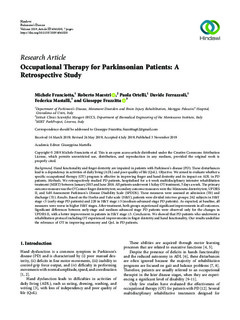| dc.contributor.author | Franciotta, Michele | |
| dc.contributor.author | Maestri, Roberto | |
| dc.contributor.author | Ortelli, Paola | |
| dc.contributor.author | Ferrazzoli, Davide | |
| dc.contributor.author | Mastalli, Federica | |
| dc.contributor.author | Frazzitta, Giuseppe | |
| dc.date.accessioned | 2020-01-09T11:57:26Z | |
| dc.date.available | 2020-01-09T11:57:26Z | |
| dc.date.issued | 2019 | |
| dc.identifier.citation | Michele Franciotta, Roberto Maestri, Paola Ortelli, Davide Ferrazzoli, Federica Mastalli, and Giuseppe Frazzitta. (2019) Occupational Therapy for Parkinsonian Patients: A Retrospective Study. Parkinson’s Disease, 2019, Article ID 4561830. | nb_NO |
| dc.identifier.uri | http://hdl.handle.net/11250/2635520 | |
| dc.description.abstract | Background: Hand functionality and finger dexterity are impaired in patients with Parkinson’s disease (PD). These disturbances lead to a dependency in activities of daily living (ADL) and poor quality of life (QoL).
Objective: We aimed to evaluate whether a specific occupational therapy (OT) program is effective in improving finger and hand dexterity and its impact on ADL in PD patients.
Methods: We retrospectively studied PD patients, hospitalized for a 4-week multidisciplinary intensive rehabilitation treatment (MIRT) between January 2015 and June 2018. All patients underwent 1 h/day OT treatment, 5 days a week. The primary outcome measure was the O’Connor finger dexterity test; secondary outcome measures were the Minnesota dexterity test, UPDRS II, and Self-Assessment Parkinson’s Disease Disability Scale (SPDDS). These measures were assessed at admission (T0) and discharge (T1).
Results: Based on the Hoehn and Yahr scale (H&Y), patients were divided into two groups: 262 subjects in H&Y stage <3 (early-stage PD patients) and 220 in H&Y stage ≥3 (medium-advanced stage PD patients). As expected, at baseline, all measures were worse in higher H&Y stages. After treatment, both groups experienced significant improvements in all outcomes. Significant differences between early-stage and medium-advanced stage PD patients were observed only for the changes in UPDRS II, with a better improvement in patients in H&Y stage ≥3.
Conclusions: We showed that PD patients who underwent a rehabilitation protocol including OT experienced improvements in finger dexterity and hand functionality. Our results underline the relevance of OT in improving autonomy and QoL in PD patients. | nb_NO |
| dc.publisher | Parkinson’s Disease | nb_NO |
| dc.rights | Navngivelse 4.0 Internasjonal | * |
| dc.rights.uri | http://creativecommons.org/licenses/by/4.0/deed.no | * |
| dc.subject | occupational therapy | nb_NO |
| dc.subject | Parkinson’s disease | nb_NO |
| dc.subject | nevrologiske lidelser | nb_NO |
| dc.title | Occupational Therapy for Parkinsonian Patients: A Retrospective Study | nb_NO |
| dc.type | Journal article | nb_NO |
| dc.source.volume | 2019 | nb_NO |
| dc.source.journal | Parkinson’s Disease | nb_NO |
| dc.source.issue | Article ID 4561830 | nb_NO |
| dc.identifier.doi | https://doi.org/10.1155/2019/4561830 | |

